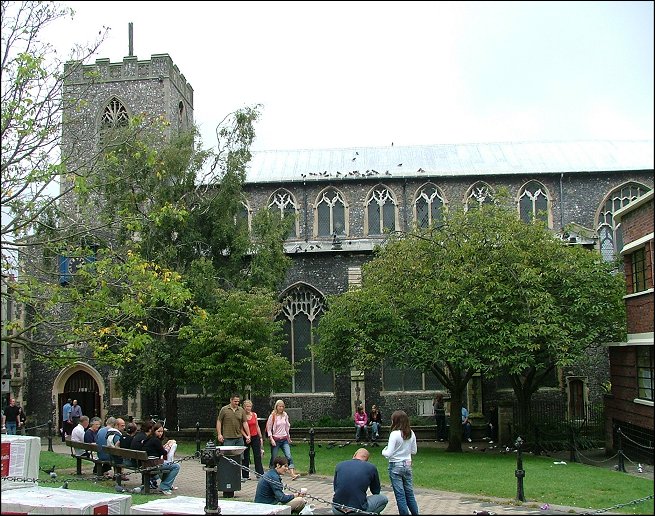
home I index I latest I glossary I introductions I e-mail I about this site
St Gregory, Norwich

| St
Gregory, Norwich St Gregory is among the most interesting of the redundant churches of Norwich. It is the most easterly of the five churches along St Benedicts Street, but it is more familiar for its southern side; its graveyard was cleared a century ago, and forms a town square onto Pottergate, giving the building quite a presence in the urban landscape. In some towns, you'd think this was the heart of the place. The height of the late 14th/early 15th century nave is accentuated by the way the eight window clerestory was built almost up to the bell windows of the tower. This tower has some evidence to suggest that it is Saxon in origin, although what you see today is almost all Richard Phipson's 1870s refacing of a 14th century shell. It supported a spire until the 18th century, a compensation perhaps for not being taller. To the east is the chancel with enormous windows, and a sloping tunnel beneath to accomodate St Gregory's Alley. You enter through the grand two-storey porch, which is set directly into the tower like that to the north. The lower level is vaulted, and there are three sculpted bosses, still bearing their original colour. The subjects are not immediately clear; Pevsner recognised St Gregory teaching music, and a martyr going to execution. Ununsually, there are large seats built up within the window splays. You step inside to a building that is reminiscent of St Lawrence, immediately across St Benedict's Street; the eye is drawn eastwards by the marching lines of unbroken arcades, and the chancel builds in steps to a wooden altar which is about eight feet above the nave floor. This is to accomodate the tunnel beneath. A modern reredos of the sun rising over the sea is not unattractive, and the only other feature in the body of the nave is the fine 14th century font. Not far away in the east end of the south aisle is the 17th century tomb chest of Francis Bacon, and there are a number of good 17th and 18th century memorials around the church. Some medieval misericords survive, and there is a good fretwork royal arms of Victoria, unusual in a town church. That this was a solid town church before redundancy can be deduced by comparing George Plunkett's 1938 photographs with mine. The great hanging rood that he saw here is now a few miles off at Easton. One of the most interesting places to wander is the ringers gallery under the tower - there is a whole set of rooms up here, the upper storeys of the porch opening into the space, and the steps to the tower leading off of that to the north. I found it open, and was tempted to wander up, but there was no light; and, as I also have a mortal fear of heights, I didn't. Simon Knott, December 2005 |
You can see thousands of George Plunkett's other old photographs of Norwich on the Plunkett website
Amazon commission helps cover the running costs of this site.
home I index I latest I introductions I e-mail I about
this site I glossary
Norwich I ruined churches I desktop backgrounds I round tower churches
links I small
print I www.simonknott.co.uk I www.suffolkchurches.co.uk